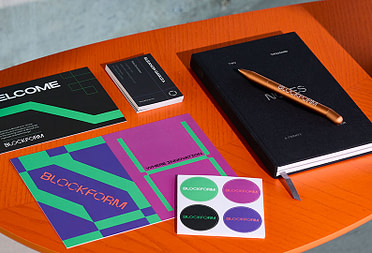Plan on paper: 9 notebook organization tips for work

Turn your work notebook from a collection of pages to a full-blown personal planning hub using these easy notebook organisation ideas and techniques.
Our Hardcover Notebooks are at home in just about any setting, from bedside journal to field sketchbook. But using a notebook for work can really help you keep on top of things, especially if you have a lot on your plate.
What makes a simple notebook a saviour for your job?
Because it’s an offline system, a notebook planner helps you to clear mental space away from your digital world while you’re using it. It’s 100% free from interruptions – there’s no risk of an email notification derailing your train of thought, and no temptation to switch your attention over to social media for a moment. You can also use it anywhere, regardless of Wi-Fi signal or battery power.
It doesn’t have to be an either-or situation, though. For many people, the best way to use a work notebook is alongside digital tools that also help maximise productivity. Maybe that means setting an alarm on your phone to create a new page layout for the week ahead, or using cross-referencing to link up information in your notes app to the index of your planner.
If you maximise opportunity to use your notebook for work, it can add real satisfaction to your working day. After all, there’s nothing like a clean white page to inspire and focus you on the task ahead.
Here’s a handy collection of tips for how to organise your notebook for ultimate productivity:
1. Know what you need from your work notebook

Every successful project starts with a planning stage, and creating a proper notebook organisation system is no exception. Think about how to organise your notebook before you uncap that pen. (Planning your planner might sound a bit weird, but bear with us.)
Start by asking yourself some questions to help figure out how your planner can be most useful to you.
- What regular tasks does your job involve?
- What do you need to know and when?
- How often will you be able to write down notes or review them?
- Who else (if anyone) needs to understand the system?
Visualise how you’ll be using your notebook in your daily routine. Will you sit down and update it each morning, or at the end of the day? Will you be bringing it to meetings, keeping it in your bag, or will it live on your desktop or in a drawer?
Thinking about these factors will help you choose the right size and format of notebook. If your planner is going to live in your backpack or purse, you may look for a smaller sized journal with a hardwearing cover, for example.
2. Review your notebook organisation options
Paper planning is having a real renaissance at the moment, and there’s a big community out there using notebooks and journals for productivity and organisation. That means there’s a range of notebook organisation systems to pick and choose from, such as the Bullet Journal – arguably the daddy of them all – or the weekly spread, the Eisenhower Matrix or the Strikethru method.
Spend some time researching the systems others have developed to see if any of them suit you. If no existing notebook organisation ideas quite fit the bill, you can always pick and choose the elements that work for you and create your own hybrid system, or come up with a method of your own from scratch.
It’s important to make sure the kind of organisational system you choose works for you, rather than becoming a task that costs you more effort than it saves. If your notebook system isn’t suited to your needs, there’s a good chance it will end up lying in a drawer rather than contributing to your productivity.
3. Number your pages

This step will make using your planner much easier, whatever layout method you use. As soon as you unwrap your new notebook, the first job is to write in page numbers. You can add them to every page, or number each leaf, depending on the size of the pages and what you’ll be using them for.
4. Add an index
One thing nearly all notebook planner aficionados agree on is the importance of an index page. Whether you’re a BuJo beginner or a back-to-basics to-do-list fan, an index could be the secret sauce your notebook needs.
The index is usually one of the first pages or spreads in a notebook, and it lists out the contents of the rest of the book. This is where your page numbers come in. You’ll be referencing them in the index and noting briefly what each one contains.
For example:
- 13. January round-up
- 42. Books to read
- 54. Secret Santa gift list
5. Make it colourful
If you’re wondering how to organise a notebook effectively, colour is a great tool for making your planner more functional and adding another layer of information to the written word. It’s also an excuse to get out your favorite coloured pens and inks, or to invest in some new ones.
You could use coloured highlighters to identify different categories or topics in your weekly spreads or to-do lists, or write in different coloured fineliners or inks to help more urgent or time-consuming tasks stand out from the rest.
If you use more than a couple of colours, add a color key somewhere in your journal, maybe after the index, to remind you at a glance of what each one means.
6. Get accessorising

You can add functionality and make your notebook more uniquely personal by using additional stationery.
Post it notes can be a handy way to re-organise tasks multiple times when you need to. Instead of writing directly on the page, write tasks or timeblocks onto post-its and place them in your weekly or daily spread. If priorities change, it’s easy to switch them around, add or remove them. Post its also make handy section dividers when you place them at the edge of your pages.
Stickers, clips and washi tape are also popular and convenient ways to customise your journal. Use them to color code or highlight text, or decorate different months or sections distinctively in your own personal style.
7. Section out your work notebook
If you have several big projects on the go at once, or your job role involves a few separate areas of responsibility, your planner should reflect that. For example, if you run a blog and two social media accounts and also have responsibility for email marketing, you’ll need 4 separate sections.
It can also be helpful to chunk out your notebook according to the different ways you use it. For example, you might dedicate one section to to-do lists, another to note-taking during meetings, and another for goals and objectives you need to meet on a monthly or quarterly basis.
Use bookmark ribbons or dividers to section your notebook into different areas so you can flip between them easily.
8. Use multiple volumes
Sometimes, one notebook is not enough. If you find that using a notebook to organise your work life suits you, why not expand your system into multiple volumes?
Alongside your main planner, you could have a meetings notebook that gives you space for pre-meeting prep as well as minute-taking and follow-up tasks list. Or a brainstorming journal with blank or dotted pages for capturing related ideas and sketching out systems and processes for your projects.
For some people, it’s helpful to have an on-the-go pocket journal, which can be used for rough notes and ad hoc tasks, and also a desktop planner which has a more intentional structure and formal layout.
If you use multiple notebooks of the same type, consider buying different colours or labelling the spines so you can tell them apart easily when you’re grabbing one from your desk or packing your bag for work in the morning.
9. Stow your stuff
Notebooks can help you keep track of physical items as well as notional ones.
Use the stick-on pocket included with your MOO Hardcover journal to stash any notes you’ve taken on the fly, along with things like receipts for your business expenses, postage stamps and travel tickets, so you’ll have them handy when you’re ready to file or digitise them. You can also use it to keep a business card handy at all times!
If your journal doesn’t come with a pocket already included, you can create one by attaching a rectangular piece of card or stiff paper to the inside cover on three sides using tape or staples.
Ready to start your paper productivity journey? Browse our beautiful new hardcover and softcover journals.
And if you’re looking to create something truly unique, fill in our simple form below, and a member of our team will be in touch to bring your ideas to life.
Keep in touch
Get design inspiration, business tips and special offers straight to your inbox with our MOOsletter, out every two weeks.



